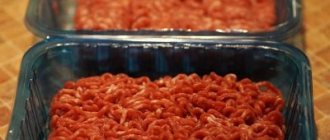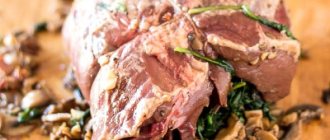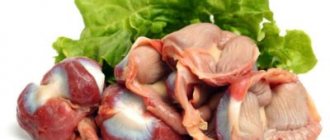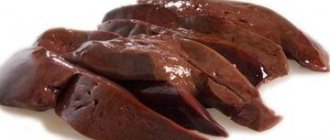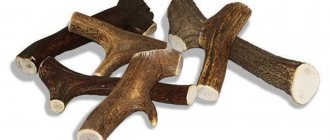06/02/2021 27 209 Dog nutrition
Author: Olga
Is a sugar bone suitable for a dog's diet? The opinions of dog breeders on this matter vary greatly. Some believe that this is a fairly harmless treat, as well as a way to keep their pet occupied. Others say that it is not only useless, but also a dangerous product for the animal. In this article we will take a closer look at both points of view.
[Hide]
Can I give my dog a sugar bone?
First, let’s figure out what kind of bone we’re talking about. A sugar bone is a large beef bone that is covered with cartilage, has a spongy tissue structure, and has a jointed head. Why is it sugary? It is called this way not because it is made of sugar, but because the head of the bone has a smooth surface, white in color, like sugar. It’s worth making it clear here that you shouldn’t give sweets to dogs at all. A dog is a carnivore by nature and it simply cannot digest glucose. The consequences of eating sweets can be poisoning, intestinal problems, problems with teeth and eyes, and allergies. You should also not think that if nothing happened once, then everything will be fine in the future. The effect of sweets on a dog’s body is cumulative and greatly affects his liver.
Owners of small dogs need to be even more careful. Sweets have an even more detrimental effect on the body of small dogs and can even lead to diabetes. If your pet is very interested in such treats, then sweets can be replaced with dried fruits and fruits, which definitely will not harm the dog.
Positive reviews
Why do some people think that it is okay to give a sugar seed? Let's figure out who this tasty treat is suitable for:
- First of all, it is recommended to give this treat to puppies at the age of 4.5-6 months. At this age, babies' teeth change and they often chew on everything around them. The bone will help loosen them and help them fall out faster.
- This bone is a natural abrasive for cleaning teeth. If you give it 1-2 times a month to puppies older than 6 months of age, it will serve as a good preventive measure against tartar.
Negative sides
Next, let’s look at why supporters of the opposite opinion believe that such a treat should not be given to a dog:
- Eating bones causes your pet's teeth to wear down and crumble. Under no circumstances should they be given to elderly animals, as well as dogs with weak gums. It is better to pamper such pets with store-bought treats or homemade treats.
- Bones are not digested very well and frequent consumption of them can clog the stomach and cause constipation.
- Pets with discipline problems should also not be given bones. The dog may begin to guard her, defend her and bare her teeth.
- This treat is also not suitable for small dog breeds. It is better for them to immediately separate pieces of cartilage or tendons. Or make them some healthy cookies with your own hands from our recipe below.
- Raw bones can contain a huge amount of bacteria, so poisoning is possible.
Can watermelon be included in a dog's diet?
A dog by nature is a predator, and it is common for it to eat meat. You might think that the animal eats nothing except raw meat, which is not true. You can treat your pet to watermelon, especially if he is crazy about it, but you should not include watermelon in the main diet.
Some tips when feeding watermelon:
- When a dog eats watermelon, its urinary system begins to actively work. Therefore, if your pet lives in an apartment, you should closely monitor it and take it to the toilet on time.
- Before giving watermelon, you should remove the rind and seeds from the pulp so that your pet does not damage the tissue of the mucous membrane or stomach.
When a dog eats a watermelon and enjoys it, there is nothing wrong with it. However, you should not give your dog watermelon if it is a GMO-grown watermelon.
You can find out whether your dog can have milk, watermelon and other fruits and vegetables from the video from the Lina Vet Vet Advice channel.
Which dogs are recommended for sugar bones?
From all of the above, we can conclude that, in principle, bones can be given, but not too often, about once or twice a month, and only to medium and large breeds. The dog must have healthy teeth and oral cavity, and no behavioral problems. If the pet begins to guard the sugar bone and show aggression, then such a treat should not be given. Training will help you stop your dog from growling at its owner when eating. Here is a video on this topic (author: Walk Service).
A dog breeder who takes his animal to shows should think twice about whether to spoil his dog with bones. After all, even partial tooth loss can cost a pet the loss of his career. Here it’s better to play it safe and limit yourself to special bones from the store or homemade delicacies. Small puppies who have not reached the age of changing teeth should not be given a sugar bone, but adults can sometimes be given a sugar bone to prevent tartar. The seeds contain a lot of useful calcium, so they can be added to the diet as a source of calcium.
What fruits, vegetables and grass are allowed for pets?
You can encourage your furry friend through fruits and vegetables. Without the addition of GMOs, fruits and vegetables are a storehouse of vitamins, thanks to which your pet will have healthy coat and skin.
Adding vegetables, fruits and grass to your dog's diet will benefit you, but you need to know what vegetables you can and cannot feed.
For example, if the dog asks, you can safely include the following vegetables in your diet:
- carrots (stewed or grated with sunflower oil);
- zucchini
From fruits:
- apples;
- papaya;
- kiwi;
- bananas.
A dog that eats vegetables and fruits is a healthy dog.
Before giving a treat for some merit or simply for good behavior, vegetables and fruits must be washed and pitted. It is better that each fruit is grown with your own hands, because then you can be 100% sure that it is a natural vegetable and fruit.
If you notice your dog eating grass, you need to take action. You should not walk her in places near the highway, where dirt, dust and exhaust fumes will settle on the grass. It’s better not to put your pet in danger and grow grass or even cereals yourself. Suitable seeds can be purchased at a specialty store.
No doctor can actually give a specific answer to the question of why dogs eat grass, however, based on numerous reviews, we can conclude that when a dog eats it, it thus wants to replenish the supply of nutrients in the body. In the video below you can see what fruits and vegetables dogs can and cannot eat (author - Anja Ilvreke Dogmama).
How to make a healthy treat with your own hands
If you still have concerns about the sugar bone, why not replace it with a healthy, homemade treat? You can, for example, prepare a treat from protein-rich liver. To prepare such a healthy delicacy with your own hands we will need:
- wheat flour - 130 grams;
- Hercules cereal - 80 grams;
- pre-boiled liver - 50 grams;
- chicken egg - 1 piece;
- vegetable oil - 1 tbsp;
- clove bud - 2 pieces.
Instructions on how to make your own dog biscuits:
- The boiled liver needs to be chopped and placed in the oven over low heat to dry slightly.
- Lightly grind Hercules in a coffee grinder or grind in a mortar. Grind the cloves into powder.
- To prepare the dough for our cookies with your own hands, you need to mix flour, ground rolled oats, cloves, egg and butter. You can add water to adjust its thickness.
- Now all that remains is to roll out the dough into a pancake and sprinkle the dried liver on top. The pancake is folded in half and rolled out until the liver is evenly distributed over the workpiece.
- Roll out the dough one last time, cut into convenient portions and place in the oven on a baking sheet lined with baking paper. Cookies are baked for 20-30 minutes over low heat.
Another simple recipe for making tasty treats for your beloved dogs. You will need:
- a quarter glass of milk powder;
- 250 grams of meat baby food;
- a quarter cup of semolina.
To prepare delicious balls for dogs, simply mix all the ingredients, knead well, form into balls and place in the oven at 150 degrees for 15 minutes. The treat is stored in the refrigerator, you can even make it for future use and freeze it.
This homemade delicacy is not only healthy, but also much cheaper than any store-bought one, and you can be one hundred percent sure of its composition.
Sorry, there are no surveys available at this time.
What can be dangerous
It is better to avoid some industrial products, including widely used ones, so as not to harm your pet’s health.
Ruminant intestines
In most cases, the intestines are not cleaned before cooking, which means that harmful bacteria and digestion products remain in it. Such food can cause an upset stomach in the dog or lead to serious illnesses, including hepatitis.
Rawhide and ears
Ears and skin are usually used to make chew toys. During the production process, these products, especially leather, are treated with a large number of harmful substances, including formaldehyde and bleaches. During laboratory tests, arsenic, mercury, lead and a number of other dangerous compounds were found in some of these “treats”. Even if the dog is not poisoned immediately, the poisons will accumulate in his body, inevitably leading to serious illness and even death.
Video “What bones should I give my dog?”
Still not sure what you can give your pet and what you should refuse? This video will tell you which bones are suitable for a dog to eat. Author of the video: Dog training LIROS.
Was this article helpful?
Thank you for your opinion!
The article was useful. Please share the information with your friends.
Yes (100.00%)
No
X
Please write what is wrong and leave recommendations on the article
Cancel reply
Rate this article: ( 4 votes, average: 4.50 out of 5, Thank you for your vote! )
Discuss the article:
Dairy products in a dog's diet
If you decide to feed your four-legged friend milk and similar products, then you need to do this gradually and carefully. Milk can cause problems with the dog's gastrointestinal tract.
- You can give your dog low-fat kefir and cottage cheese, but you cannot overdo it with cottage cheese, otherwise your pet will become constipated.
- It is recommended to give yogurt to an adult dog or puppy after 3 months. It should be natural, unsweetened, without preservatives or harmful additives.
- Milk should not be given to an adult dog, because there is a risk that it will not be accepted. If the pet has been fed milk throughout its life, then there is no need to worry, but if after feeding with mother’s milk you have protected the puppy from it, do not risk it. Milk intolerance can even lead to an allergy to the protein contained in milk.
- You should not feed your pet condensed milk. Condensed milk contains a lot of sugar and other unhealthy ingredients.
Apricot kernels: benefits
By consuming apricot kernels in moderation, you can count on positive effects. This product is believed to have:
- antimicrobial
- anti-inflammatory
- anti-aging
- regenerating
- antitumor
- immunomodulatory
- antioxidant effect.
Apricot kernels are useful for preventing complications of respiratory diseases. The substances contained in the kernels have a beneficial effect on the kidneys and urinary system. Bones are used to treat and prevent diseases of joints and muscle tissue. They are also useful for the hematopoietic system. In the old days, apricot kernels were used to seriously treat whooping cough, bronchitis and other childhood infectious diseases. It is known that the main food of the centenarians of the Hunza tribe, whose age reaches 120 years, is apricots - fruits and seeds.
In modern medicine and cosmetology, oil, milk, crushed suspension, and extracts based on apricot kernels are widely used. It is believed that the substances contained in this part of the fruit slow down aging, increase tissue elasticity, and produce regenerative processes.
Apricot kernels are good for men's and women's health. They have a beneficial effect on hormonal levels, improve the condition of the nervous system, and saturate the body with iron, vitamins and other bioactive elements.
What you can pamper
Beef callus, a large femur with the remains of meat, as well as ribs at the cartilage stage are practically the only type of bones that are given to a pet. After he gnaws all the meat and cartilage tissue, even such harmless beef bones must still be taken away.
Lamb is considered environmentally friendly and nutritious. Almost does not cause allergic reactions, because it is a rare source of protein in the diet of pets, unlike beef or chicken. Sometimes you can give lamb bones to chew on. But only soft boiled cartilage or very large fragments that cannot be eaten quickly are suitable for this. You definitely need to have time to pick them up before they are chewed into small pieces. An unusual delicacy is cartilaginous veal ribs. You can cook porridge using various parts of bones. After the dish is completely ready, they must be removed.
Although certain types of bones are relatively safe to eat, they should only be offered to your pet as a toy or temporary entertainment.


